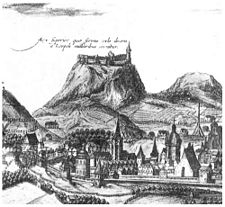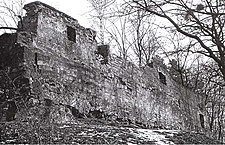Lviv High Castle
| Lviv High Castle | |
|---|---|
| Високий замок | |
| Lviv | |

A fragment of Lviv engraving by A. Gogenberg, 17th century
|
|

Part of the South Wall of High Castle.
|
|
| Site information | |
| Condition | ruins |
| Site history | |
| Built | 1250 |
| Materials | wood (initially) |
| Demolished | 1869 |
The Lviv High Castle or Lviv Castle Hill (Ukrainian: Високий замок / Замкова гора, Vysokyi zamok / Zamkova hora; Polish: Wysoki Zamek) is a historic castle located on the top of the Castle Hill of the city of Lviv. It is currently the highest point in the city, 413 metres (1,355 ft) above sea level. The castle currently stands in ruins.
The High Castle is located in close proximity of the centre of Lviv (see picture), formerly being surrounded by a fortification wall. The Castle Hill took its name from the High Castle (as opposite to the other, Low Castle), which used to be located on the hill from the 13th century to the late 19th century. The castle was a main defensive fort of the city during its existence.
As it follows from Rus' Chronicles, the first fortifying structures appeared on the Castle Hill in the time Halych-Volhynia, and were built by Leo I of Halych from wood. It was originally a wood and soil construction, as most others at that time. In 1259 by a request of Burunday Khan they were destroyed, but in 1270 were rebuilt. In 1340, when Lviv was captured by Casimir III of Poland the wooden castle was put under fire. In 1353 it was destroyed again by Lithuanians. A new brick castle appeared on the hill in 1362 by the king Casmimir III. It became the residence of Polish nobles.
The castle was rebuilt and repaired many times. In the times of Khmelnytsky Uprising it was taken by Cossack forces of Colonel Maksym Kryvonis in October 1648. In 1704, when Lviv was occupied by Swedes the castle was heavily damaged. In 1777, Austrians initiated disassembling of fortifications around the castle.
In the 19th century, the then destroyed castle was taken apart and new items were built in its place. The fortification was strengthened, trees were planted on the hill's slope, and a park was constructed. On the place where the castle once stood, a Union of Lublin Mound was constructed in 1869, dedicated to the 300-years of the Union of Lublin. Currently, an observation platform is located atop the kurgan. In 1957, a 141-meter tall television tower was constructed on a ridge of the hill (see picture).
...
Wikipedia
